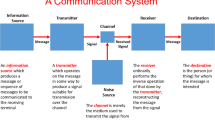Abstract
One of the major impediments to understanding the concept of information is that the term is used to describe a number of disparate things, including a property of organized matter and messages sent from a sender to a receiver. Information is essentially an attribute of the form that matter and energy take, not of matter and energy themselves. Intrinsic information is a theoretical measure of the degree to which an entity is organized, the opposite of entropy. Meaningful information, however, involves the detection of a pattern of organized matter or energy by an animate or a man-made receptor, which triggers a change in the behavior, function, or organizational structure of the receiving entity. The ability to detect and respond to meaningful information is one of the defining characteristics of living entities; the process that enables cells and organisms to receive their genetic heritage, regulate their internal milieu, and respond to changes in their environment. Although energy and information are the two fundamental causal agents in the natural world, they bring about change through completely different mechanisms. The energy involved in physical interactions is supplied by the originating entity, while the energy involved in informational interactions is provided by the recipient. There is no predictable relationship between the nature of the informational stimulus and the response it engenders, for this is primarily determined by the pattern of connections between the involved receptors and effectors that evolution and learning have fashioned. As a result, a living entity’s response to information cannot be predicted on a purely mechanical basis. The laws that describe the physical interaction of organized matter apply to the transfer of energy, not to the transfer of information. This is why biology cannot be reduced to physics.
Similar content being viewed by others
References
Adler J (1966) Chemotaxis in bacteria. Science 153: 708–716.
Attneave F (1959) Applications of Information Theory to Psychology. New York: Henry Holt.
Baddeley R, Hancock P, Foldiak P, eds (2000) Information Theory and the Brain. Cambridge: Cambridge University Press.
Bolton D, Hill J (2004) Mind, Meaning, and Mental Disorder: The Nature of Causal Explanation in Psychology and Psychiatry. New York: Oxford University Press.
Bourtchouladze R (2002) Memories Are Made of This: How Memory Works in Humans and Animals. New York: Columbia University Press.
Bray D (1975) Protein molecules as computational elements in living cells. Nature: 376: 307–712.
Cairns-Smith AG (1966) Evolving the Mind: On the Nature of Matter and the Origin of Consciousness. Cambridge: Cambridge University Press.
Dretske FI (1981) Knowledge and the Flow of Information. Cambridge, MA: MIT Press.
Dretske FI (2000) Perception, Knowledge, and Belief: Selected Essays. Cambridge: Cambridge University Press.
Forbes N (2004) The Imitation of Life: How Biology is Inspiring Computing. Cambridge, MA: MIT Press.
Freeman WJ (2001) How Brains Make Up Their Minds. New York: Columbia University Press.
Gatlin LL (1972) Information Theory and the Living System. New York: Columbia University Press.
Gell-Mann M (1994) The Quark and the Jaguar: Adventures in the Simple and the Complex. New York: Freeman.
Glimcher PW (2003) Decisions, Uncertainty, and the Brain: The Science of Neuroeconomics. Cambridge, MA: MIT Press.
Glynn I (1999) An Anatomy of Thought: The Origin and Machinery of the Mind. New York: Oxford University Press.
Harold FM (1986) The Vital Force: A Study of Bioenergetics. New York: Freeman.
Johnston VS (1999) Why We Feel: The Science of Human Emotions. Reading: Perseus Books.
Kåhre J (2002) The Mathematical Theory of Information. Boston: Kluwer.
Kandel ER (2006) In Search of Memory: The Emergence of a Science of Mind. New York: Norton.
Kelso JAS (1995) Dynamic Patterns: The Self-Organization of Brain and Behavior. Cambridge, MA: MIT Press.
Loewenstein WR (1999) The Touchstone of Life: Molecular Information, Cell Communication, and the Foundations of Life. New York: Oxford University Press.
MacKay DM (1969) Information, Mechanism and Meaning. Cambridge, MA: MIT Press.
Mayr E (1997) This is Biology: The Science of the Living World. Cambridge, MA: Harvard University Press.
Niehoff D (2005) The Language of Life: How Cells Communicate in Health and Disease. Washington, DC: Joseph Henry Press.
Orengo C, Jones D, Thornton J (2003) Bioinformatics: Genes, Proteins and Computers. Oxford: Bios Scientific.
Reading A (2004) Hope and Despair: How Perceptions of the Future Shape Human Behavior. Baltimore: Johns Hopkins University Press.
Sarkar S (2005) Molecular Models of Life: Philosophical Papers on Molecular Biology. Cambridge, MA: MIT Press.
Searle JR (2004) Mind: A Brief Introduction. New York: Oxford University Press.
Shannon C, Weaver W (1964) The Mathematical Theory of Communication Urbana: University of Illinois Press.
Stonier T (1997) Information and Meaning: An Evolutionary Perspective. London: Springer.
Tweed D (2003) Microcosms of the Brain: What Sensorimotor Systems Reveal about the Mind. Oxford: Oxford University Press.
Von Bayer HC (2004) Information: The New Language of Science. Cambridge, MA: Harvard University Press.
Whitfield JC (1984) Neurocommunications: An Introduction. Chichester: Wiley.
Wicken J (1987) Evolution, Thermodynamics, and Information: Extending the Darwinian Program. New York: Oxford University Press.
Wiener N (1948) Cybernetics or Control and Communication in the Animal and the Machine. New York: Wiley.
Wiener N (1967) The Human Use of Human Beings. New York: Avon Books.
Young P (1987) The Nature of Information. New York: Praeger.
Author information
Authors and Affiliations
Corresponding author
Rights and permissions
About this article
Cite this article
Reading, A. The Biological Nature of Meaningful Information. Biol Theory 1, 243–249 (2006). https://doi.org/10.1162/biot.2006.1.3.243
Received:
Accepted:
Published:
Issue Date:
DOI: https://doi.org/10.1162/biot.2006.1.3.243




